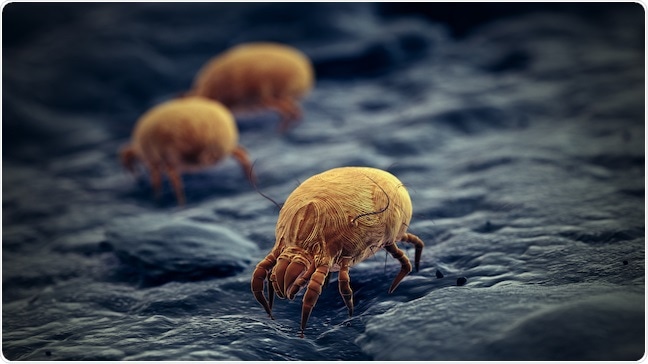House dust mites can be found everywhere around the world. When individuals do some cleaning work, they will probably stir up some of these dust mites.

House dust mites are everywhere. Image Credit: La Jolla Institute for Immunology.
Although everyone has immune cells that can react to common allergens like house dust mites, a majority of the individuals do not have allergic symptoms.
Despite this, there are many individuals who do react with the usual allergic symptoms such as a runny nose, sneezing, and itchy, swollen nasal passages, while others have a relatively severe reaction: an asthma attack that can be life-threatening.
Hence, to treat the root cause of asthma and allergies, scientists should know precisely what sets these individuals apart from healthy persons.
In the latest study published in the Science Immunology journal on June 12th, 2020, researchers from La Jolla Institute for Immunology (LJI) have provided a clue to why non-allergic persons do not show a strong response to house dust mites.
The scientists exposed a formerly unknown subset of T cells that may regulate asthma and allergic immune reactions from ever developing in reaction to house dust mites—and other potential allergens.
We discovered new immune cell subsets and new therapeutic opportunities, this new population of cells could be one, out of many unknown mechanisms, that explains why healthy people don’t develop inflammation when they breathe in allergens.”
Grégory Seumois, PhD, Study Co-Leader, Instructor, and Director of Sequencing Core, La Jolla Institute for Immunology
According to Professor Pandurangan Vijayanand, MD, PhD, the study’s senior author and Professor from La Jolla Institute for Immunology, “The study highlights the power of unbiased single-cell genomics approaches to uncover novel biology.”
The research is based on Vijayanand laboratory’s skills in associating the expression of genes with disease development. The researchers also leveraged the Immune Epitope Database, an LJI-headed resource that houses data on how the immune system communicates with allergens like house dust mites.
Why house dust mites? These tiny critters are difficult to avoid, which implies that almost everyone has been exposed to these organisms. Even in persons who lack a house dust mite (HDM) allergy, the immune system may react in a certain way as it learns to identify HDM molecules. This renders HDM a helpful model for exploring what causes asthma attacks and allergies.
The LJI researchers employed a technique, which is part of the “genomic revolution” arsenal of tools, known as single-cell RNA-seq (or single cell transcriptomics) to observe accurately which molecules and genes specific to T cells produce as a reaction to HDM allergens.
The researchers tested cells from four groups of individuals: people with HDM allergy and asthma, people with only HDM allergy, people with asthma but without HDM allergy, and healthy people.
The team’s analysis implies that a subset of helper T cells, known as interleukin (IL)-9 Th2 expressing HDM-reactive cells, is more common in the blood of individuals suffering from HDM-allergic asthma compared to those who are allergic to HDM alone.
Additional analysis implied that those IL9-TH2 cells are enriched in a set of genes/molecules that raised the cytotoxic potential of those cells. This means such specific T cells could destroy other cells and contribute to inflammation.
On the contrary, another subset of T cells stood out in the non-allergic individuals. Expressing an “interferon response signature,” these T cells were enriched for a gene that encodes a protein known as TRAIL. The research done by Seumois with his collaborators indicates that TRAIL could be significant because it could reduce the activation of helper T cells.
This discovery may mean that individuals with this specific population of cells could have less T-cell-driven inflammation in reaction to HDM allergens. This could finally offer a clue as to why certain people develop asthma and allergies while others do not.
Now if functional studies confirm this dampening effect, we’re curious if there is a way to boost the activation of these T cells or induce their proliferation in asthmatic or allergic populations, Can we act on those cells very early on, before asthma has developed?”
Grégory Seumois, PhD, Study Co-Leader, Instructor, and Director of Sequencing Core, La Jolla Institute for Immunology
For instance, genomics studies such as this may one day help identify children at risk of developing allergies and asthma. Early detection may pave the way to preemptively act on immune cells prior to the development of asthma and allergy.
While Seumois underscored that more research needs to be done, the transcriptomic technique employed for this research could speed up future research on asthma and allergies, he stated.
This is the first large-scale, single-cell, RNA-seq transcriptomic analysis for LJI, Now that we have developed the bench know-how and analysis pipeline, it could be applied to many diseases.”
Grégory Seumois, PhD, Study Co-Leader, Instructor, and Director of Sequencing Core, La Jolla Institute for Immunology
Source:
Journal reference:
Seumois, G., et al. (2020) Single-cell transcriptomic analysis of allergen-specific T cells in allergy and asthma. Science Immunology. doi.org/10.1126/sciimmunol.aba6087.